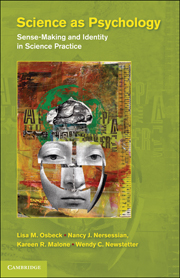Book contents
- Frontmatter
- Contents
- Acknowledgments
- 1 Introduction: Science and Persons
- 2 Methods of Study
- 3 The Problem-Solving Person
- 4 The Feeling Person
- 5 The Positioning Person
- 6 The Person Negotiating Cultural Identities
- 7 The Learning Person
- 8 Epilogue: Science as Psychology: A Tacit Tradition and Its Implications
- References
- Index
2 - Methods of Study
Published online by Cambridge University Press: 05 July 2011
- Frontmatter
- Contents
- Acknowledgments
- 1 Introduction: Science and Persons
- 2 Methods of Study
- 3 The Problem-Solving Person
- 4 The Feeling Person
- 5 The Positioning Person
- 6 The Person Negotiating Cultural Identities
- 7 The Learning Person
- 8 Epilogue: Science as Psychology: A Tacit Tradition and Its Implications
- References
- Index
Summary
In this chapter we describe the contexts of science practice that we studied and the approaches to the data collection and analysis that are the basis of this text. Along the way we note methodological issues and controversies as they relate to our analysis and apply more generally to the use of qualitative methods in psychology. Thus this chapter is comparable to the methods section of a traditional research study, but it contains departures in form in keeping with the theoretical aims of this text.
PARTICIPANTS, CONTEXT, AND HISTORY
The Laboratories
Overview
Our framing assumption is that the cognitive practices of the laboratory are both situated in the laboratory and distributed across systems of interacting persons, artifacts, instruments, and traditions. The situated approach to cognition construes intelligent behavior as arising within particular settings such that its features are dependent on that setting, in contrast with a view of cognition as an abstract realm or self-regulating process. The assertion is that “problem solving is carried out in conjunction with the environment” (Brown, Collins, & Duguid, 1989, p. 36, emphasis added). By distributed, we mean that we regard brain and environment as co-constituting a single complex system, inasmuch as the forms of sense-making and problem solving that occur would not be possible in isolation from that environment, including the social environment.
- Type
- Chapter
- Information
- Science as PsychologySense-Making and Identity in Science Practice, pp. 31 - 51Publisher: Cambridge University PressPrint publication year: 2010



